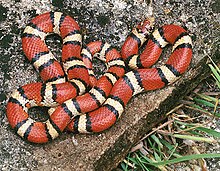Milk snake
| Milk snake | |
|---|---|
 |
|
| Red milk snake Lampropeltis triangulum syspila | |
| Scientific classification | |
| Kingdom: | Animalia |
| Phylum: | Chordata |
| Class: | Reptilia |
| Order: | Squamata |
| Suborder: | Serpentes |
| Family: | Colubridae |
| Genus: | Lampropeltis |
| Species: | L. triangulum |
| Binomial name | |
|
Lampropeltis triangulum (LaCépède, 1788) |
|
| Subspecies | |
|
24 sspp., see text |
|
| Synonyms | |
|
|
24 sspp., see text
Lampropeltis triangulum, commonly known as a milk snake or milksnake, (French: Couleuvre tachetée; Spanish: Culebra-real coralillo) is a species of king snake. There are 24 subspecies of milk snakes. Lampropeltis elapsoides, the scarlet kingsnake, was formerly classified as the subspecies L. t. elapsoides, but is now recognized as a distinct species. The subspecies have strikingly different appearances, and many of them have their own common names. Some authorities suggest that this species may be split into several separate species. They are not venomous or otherwise dangerous to humans.
They are distributed from southeastern Canada through most of the continental United States to Central America, down to western Ecuador and northern Venezuela of northern South America.
Milk snakes grow 20 to 60 inches (51 to 152 cm) long. They have smooth and shiny scales and their typical color pattern is alternating bands of red-black-yellow or white-black-red. However, red blotches instead of bands are seen in some populations. Some milk snakes have a striking resemblance to coral snakes and this mimicry (known as Batesian mimicry) likely scares away potential predators. While both milk snakes and coral snakes possess bands of red, black and yellow, common mnemonics can be used to properly distinguish between the deadly coral snake and the harmless milk snake:
However, the Eastern milk snake (L. t. triangulum) does not resemble a coral snake; instead it tends to have similar markings to that of several other snakes, particularly the fox snake, scarlet snake and most importantly, the Massassauga rattlesnake. Milk, fox, and scarlet snakes are killed because of a resemblance to the venomous rattlesnake. Juvenile milk snakes, which are more reddish than adults, are often killed because they are mistaken for copperheads. There is enough distinction among the five to make the Eastern milk snake fairly easy to identify. Eastern milk snakes also have a light colored v-shaped or y-shaped patch on their neck. One subspecies is melanistic (almost all black).
...
Wikipedia
